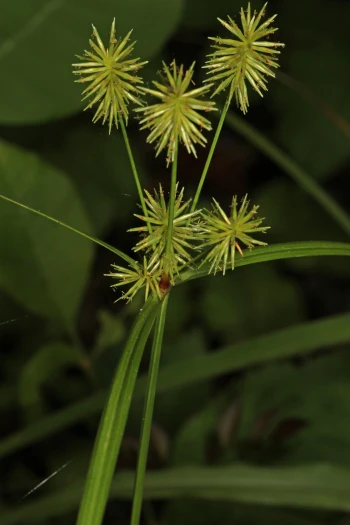(Cyperus lancastriensis)
(Cyperus lancastriensis)
/
/

Judy Gallagher
CC BY-SA 4.0
Image By:
Judy Gallagher
Recorded By:
Copyright:
CC BY-SA 4.0
Copyright Notice:
Photo by: Judy Gallagher | License Type: CC BY-SA 4.0 | License URL: http://creativecommons.org/licenses/by-sa/4.0/ | Rights Holder: Judy Gallagher | Publisher: iNaturalist | Date Created: 2018-07-06T10:40:06-07:00 |









Estimated Native Range
Climate Requirements
| • Precipitation | 36" - 69" |
| • High Temp. | 82°F - 93°F |
| • Low Temp. | 12°F - 35°F |
Summary
Cyperus lancastriensis, with no widely recognized common name, is a perennial herbaceous plant belonging to the sedge family. It is native to wetlands, marshes, and along the edges of ponds and streams in the eastern United States. This sedge typically forms dense clumps and can reach heights of 1-3 feet (0.3-0.9 meters). Cyperus lancastriensis has a grass-like appearance with triangular stems and umbrella-like clusters of narrow, greenish-brown spikelets at the top. It does not produce showy flowers, as is characteristic of many sedges, and its flowering season extends through the summer months.
Cyperus lancastriensis is valued for its ability to stabilize soil and filter water, making it useful for erosion control and in rain gardens. It is also used in naturalized plantings and as a ground cover in wet areas. This sedge prefers full sun to part shade and thrives in wet, boggy soils with poor to moderate drainage. While it is low-maintenance and can be an asset in water gardens or naturalized areas, Cyperus lancastriensis can become aggressive in favorable conditions. It is important to monitor its spread to prevent it from becoming invasive outside its native range.CC BY-SA 4.0
Cyperus lancastriensis is valued for its ability to stabilize soil and filter water, making it useful for erosion control and in rain gardens. It is also used in naturalized plantings and as a ground cover in wet areas. This sedge prefers full sun to part shade and thrives in wet, boggy soils with poor to moderate drainage. While it is low-maintenance and can be an asset in water gardens or naturalized areas, Cyperus lancastriensis can become aggressive in favorable conditions. It is important to monitor its spread to prevent it from becoming invasive outside its native range.CC BY-SA 4.0
Plant Description
- Plant Type: Grass
- Height: 1-3 feet
- Width: 1-2 feet
- Growth Rate: Moderate
- Flower Color: N/A
- Flowering Season: Summer
- Leaf Retention: Deciduous
Growth Requirements
- Sun: Full Sun, Part Shade
- Water: Medium, High
- Drainage: Medium
Common Uses
Erosion Control, Low Maintenance, Water Garden
Natural Habitat
Wetlands, marshes, and edges of ponds and streams
Other Names
Common Names: Lancashire Flat Sedge, Paper Flat Sedge
Scientific Names: Cyperus lancastriensis, Cyperus refractus var. lancastriensis, Mariscus lancastriensis
GBIF Accepted Name: Cyperus lancastriensis